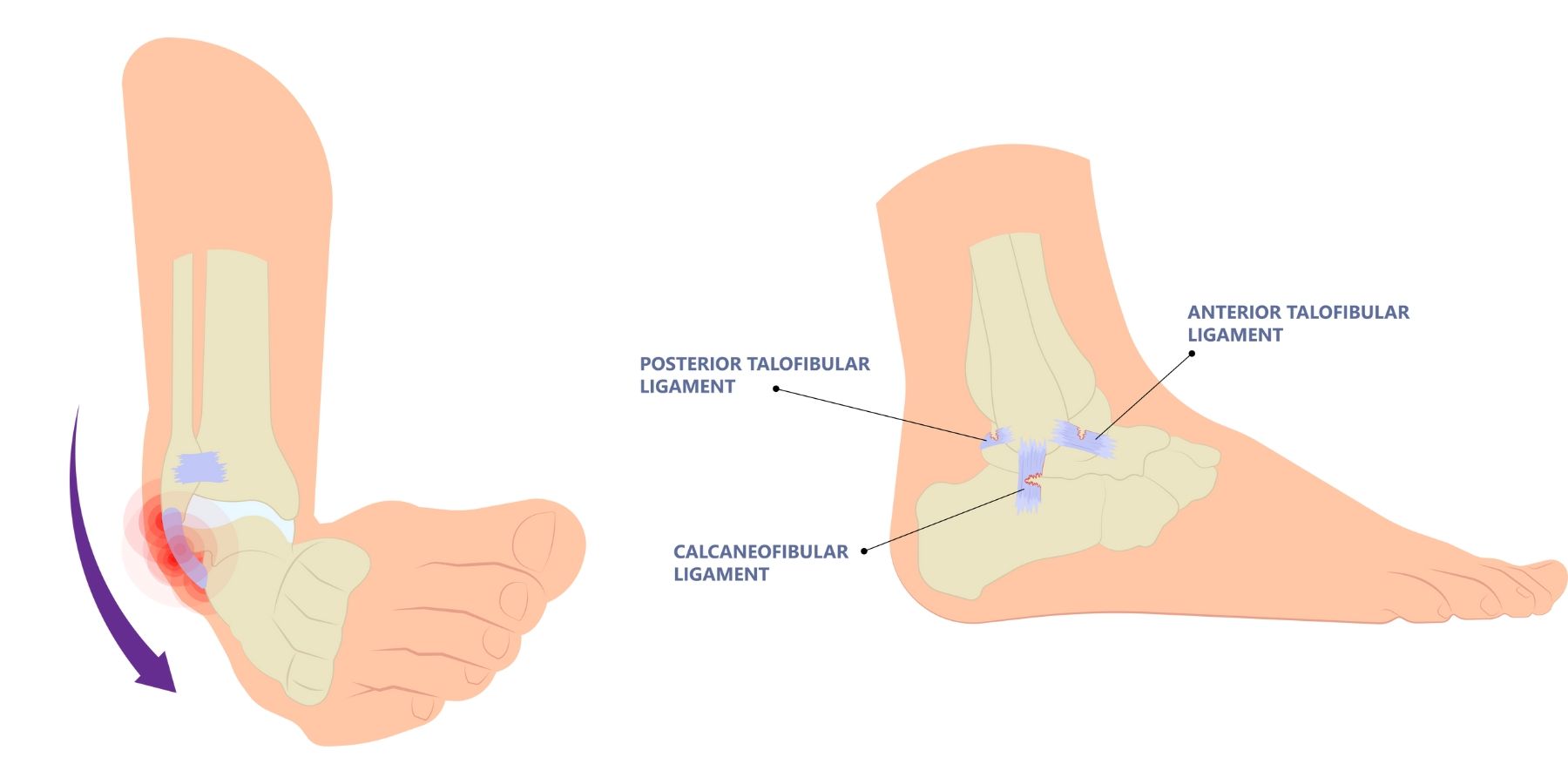Ankle Instability
What is Ankle Instability?
Ankle instability is a condition characterised by a recurrent giving way after an ‘ankle sprain’ which ruptures the ligament complex on the outside of the ankle. This instability often leads to discomfort and an increased likelihood of ankle injuries.

Impact of Ankle Instability on Anatomy and Health
Ankle instability affects the ligaments that support the ankle joint, primarily the anterior talofibular ligament (ATFL) and/or calcaneofibular ligament (CFL) on the outer side of the ankle. These ligaments may become stretched or torn, compromising their ability to stabilise the joint.
Over time, this can lead to:
- Weakened muscles and impaired coordination around the ankle.
- Joint degeneration, increasing the risk of osteoarthritis.
- Poor posture and altered gait patterns, potentially affecting the knees, hips, and lower back.
The recurring instability can also significantly impact daily life, limiting physical activities, reducing mobility, and increasing the likelihood of future injuries.
Risk Factors for Ankle Instability
Several factors can increase the risk of developing ankle instability:
- Individuals who have had one or more severe ankle sprains
- Occupations or sports activities that require frequent or intense use of the ankles (e.g. basketball or volleyball).
- Genetic factors associated with ligamentous laxity.
- Anatomical factors
Causes of Ankle Instability
The primary cause of ankle instability is the rupture or stretching out of some or all of the ligaments on the outer side of the ankle. This can occur due to an ankle sprain or repeated sprains, which can stretch or tear these ligaments. The two main ligaments commonly associated with ankle instability are the anterior talofibular ligament (ATFL) and the calcaneofibular ligament (CFL).

Symptoms of Ankle Instability
People with ankle instability often report the following symptoms:
- Recurrent ankle sprains
- A recurrent sensation of the ankle 'giving way' or feeling unstable.
- Persistent discomfort and pain, especially during activities that require ankle movement.
- Swelling around the ankle region
Prevention of Ankle Instability
Prevention of ankle instability focuses on reducing risk factors and maintaining overall joint health. Strategies include:
- Strengthening Exercises: Targeting the ankle and lower leg muscles with resistance training can enhance stability.
- Balance Training: Exercises like single-leg stands or balance boards improve neuromuscular coordination.
- Wearing Proper Footwear: Supportive shoes designed for your activity level can minimise strain on the ankle.
- Using Orthotics: Custom insoles can help correct structural imbalances.
- Taping or Bracing: These can provide extra support during high-risk activities, especially for those with a history of sprains.
- Early Treatment of Injuries: Prompt rehabilitation after an ankle sprain ensures proper healing and reduces the likelihood of chronic instability.
- Stretching and Mobility Work: Keeping the ankle joint flexible helps maintain a full range of motion.
Types of Ankle Instability
Ankle instability is generally categorised into two main types:
- Mechanical Instability: This occurs due to structural damage to the ligaments, bones, or cartilage within the ankle joint.
- Functional Instability results from neuromuscular issues, such as impaired balance, coordination, or muscle strength around the ankle.
Many individuals experience a combination of both types, often called chronic ankle instability.
Stages of Ankle Instability
Ankle instability progresses through several stages, especially if left untreated:
- Acute Stage: Follows an initial injury, such as a sprain.
- Recurrent Instability: The joint weakens after repeated sprains or insufficient rehabilitation.
- Chronic Stage: Prolonged instability leads to persistent symptoms such as swelling, pain, and limited range of motion.
- Advanced Degeneration: Long-term untreated instability can cause significant joint damage, leading to severe functional limitations and chronic pain.
Diagnosis of Ankle Instability
Dr Graff will take a history, examine your ankle, and organise imaging such as:
- X-rays: These can help detect any fractures or abnormalities in the ankle. Stress X-rays may also be conducted to review the joint appearance while stressing the ankle.
- MRI Scan: This may provide a detailed view of the ligaments and assess for damage to these.
Management and Treatment of Ankle Instability
Treatment for ankle instability aims to restore strength and balance to the ankle.
This usually involves:
- Physiotherapy: Specific exercises that can strengthen the ankle muscles and improve balance and coordination.
- Bracing: An ankle brace can provide additional support and prevent further injury.
- Medication: Nonsteroidal anti-inflammatory drugs (NSAIDs) can be used to manage pain and inflammation.
- Surgery: If the above treatments are ineffective, surgery to repair or reinforce the ligaments may be considered (see Ankle Stabilisation Surgery Information Sheet). Preventing ankle instability primarily involves reducing the risk of initial sprains and subsequent reinjury. This can include regular ankle-strengthening exercises, wearing suitable footwear, and being mindful of surfaces and activities that might increase the risk of ankle injury.
What if Ankle Instability is Untreated?
Leaving ankle instability untreated can lead to significant complications:
- Frequent ankle sprains, causing further damage to ligaments and other joint structures.
- Accelerated wear and tear of the cartilage, leading to early-onset osteoarthritis.
- Persistent discomfort may limit mobility and reduce the quality of life.
- Difficulty performing daily activities or participating in sports.
- Instability can affect gait, leading to knee, hip, or lower back problems.
Timely diagnosis and appropriate treatment of ankle instability are critical to preventing these complications and ensuring long-term joint health.
If you have any concerns or questions regarding ankle instability or have recently injured your ankle and require review, please contact us and book an appointment with Dr. Graff.
